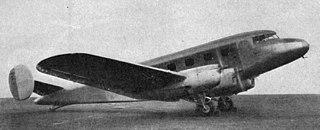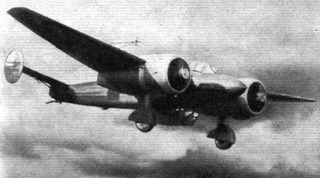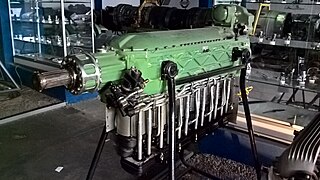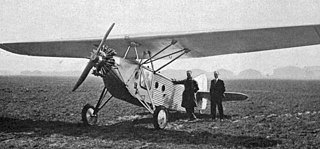
The Farman F.220 and its derivatives were thick-sectioned, high-winged, four engined French monoplanes from Farman Aviation Works. Based on the push-pull configuration proven by the F.211, design started in August 1925 and the first flight of the prototype was on 26 May 1932. The largest bomber to serve in France between the two world wars was the final F.222 variant. One variation was intended to be an airliner.

Between 1920 and 1951 the Société des Moteurs Salmson in France developed and built a series of widely used air-cooled aircraft engines.

The Gnome-Rhône 14M was a small 14-cylinder two-row air-cooled radial engine that was used on several French and German aircraft of World War II. While having the same appearance, number of pistons (14) and two-row layout typical of Gnome-Rhône radial engines, the 14M was built to a smaller frame intended to power a lighter class of aircraft. It was designed with lower displacement and power, smaller in size and with less weight compared to the larger, heavier Gnome-Rhône 14N and its well-known predecessor.

The Farman F.430 was a 1930s French light transport designed and built by the Farman Aviation Works. Two variants with different engines were known as the F.431 and F.432.

The Nord 1100 Noralpha was a French-built and re-engined Messerschmitt Bf 108 produced by Nord Aviation.

The Hanriot H.43 was a military utility aircraft produced in France in the late 1920s and early 1930s which was primarily used by the Aéronautique Militaire as a trainer. While Hanriot had spent most of the 1920s manufacturing further and further developments of the HD.14 that had flown in 1920, the H.43 was an entirely new design. It was a conventional single-bay biplane with staggered wings of unequal span and a fuselage of fabric-covered metal tube. Accommodation for the pilot and passenger was in tandem, open cockpits and the main units of the fixed, tailskid undercarriage were linked by a cross-axle.

The Hanriot H.170, H.180, and H.190 were a family of light utility aircraft produced in France in the 1930s. All introduced in 1934, they appeared side by side at the Paris Air Show that year, the model numbers distinguishing between versions powered by Salmson, Renault, and Régnier engines respectively.

The Farman NC.470 was a French twin-engined floatplane designed as a crew trainer for the French Navy. It was used in small numbers for both its intended role as a trainer and as a coastal reconnaissance aircraft at the start of World War II.

The Potez 661 was a four-engined metal low-wing monoplane airliner developed in France just before World War II. The single example flew with Air Afrique on French colonial routes.
The Dewoitine HD.730 was a prototype French reconnaissance floatplane of the 1940s. It was a single-engined, low-wing monoplane that was designed as a catapult-launched reconnaissance aircraft to operate from warships of the French Navy. Two flew in 1940, and a third aircraft was built to a modified design in 1941, but no production followed.
The Yakovlev UT-3, initially known as the AIR-17 and then Ya-17, was a twin-engine low-wing monoplane aircraft designed by Alexander Sergeyevich Yakovlev for the Soviet Air Force (VVS).

The SNCAC NC.4-10 was a twin-engine floatplane torpedo bomber built in France in the late 1930s. It was one of several prototypes competing for a Navy specification but no contracts were awarded after the military lost interest in the type.
The SNCAC NC.130 was a French high-altitude research aircraft of the 1930s. A single example flew in 1939, but was destroyed during the Second World War.

The SNCAC NC-600 was a prototype French twin-engined long-range fighter aircraft, developed by SNCAC from the earlier Hanriot H.220 fighter. The type never entered service, with development being ended by the French surrender in June 1940.

The SNCAC NC.510 was a twin-engine French reconnaissance, army co-operation or advanced training aircraft, built in the late 1930s. Three were built and refined but production orders were not forthcoming.

The Renault 6Q, also called the Renault Bengali 6, is an air-cooled inverted in-line six-cylinder, aircraft piston engine, producing about 160 kW (220 hp) continuous power. It was designed and built in France and produced for more than ten years after its homologation in 1936, with large numbers built during World War II.

The SFCA Lignel 20 was a French, single engine, low wing monoplane, one of a series of this type built by SFCA in the 1930s. It was capable of aerobatics but was primarily a racing aircraft.

The Hanriot H.46 Styx was a French, single-engined, parasol wing aircraft which could equally be configured for training, liaison or ambulance roles; in the latter form it was able to accept a patient on a stretcher. Several different engines were fitted and flown but the type did not reach production.
The Morane-Saulnier MS.152 was a French multi-purpose aircraft built in 1928. It did not go into production.

The Renault 12R was an air-cooled inverted V12 aircraft engine developed by the French engineering company Renault in the 1930s. The design was based on mounting two 6Q six-cylinder engines on a single crankshaft. In production, the engine was rated between 450 and 500 hp, although a high performance version built for the sole Caudron C.712 racing special produced 730 hp (540 kW). More than one third of production went to power the Caudron C.714 light fighter that fought in the early stages of World War II for the French and Polish Air Forces.

















